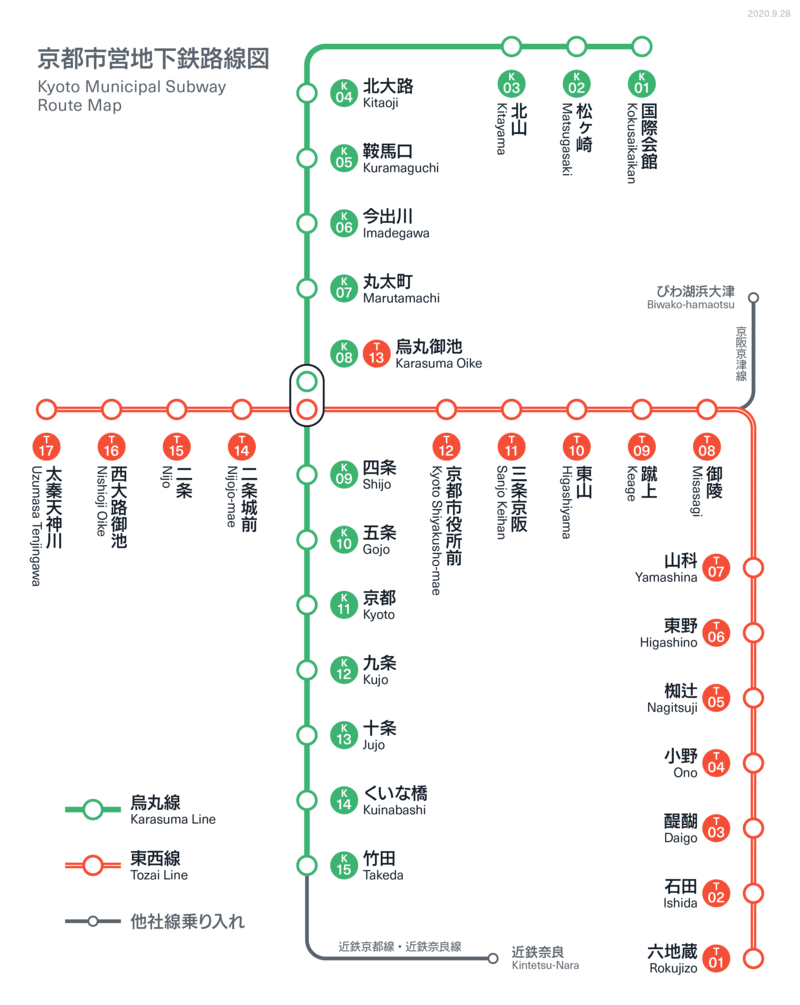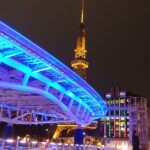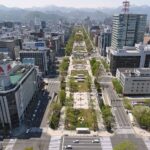Kyoto’s public transportation system is comprehensive and user-friendly, providing a wide range of options for moving around the city. Kyoto’s subway system, comprised of two lines that traverse the city and connect many of its major attractions, is the most frequently used public transportation system in the city. The Hankyu and Keihan lines of the private railway, as well as the JR (Japan Railways) lines, are also quite popular. All of Kyoto’s public transportation systems are included in the Kyoto City Bus’s one-day pass for tourists. Kyoto also has taxis, albeit they tend to be more expensive than public transportation options.
Metro system in Kyoto – 京都市営地下鉄 – Lines
Kyoto’s public transportation system is comprehensive and user-friendly, providing a wide range of options for moving around the city. Kyoto’s subway system, comprised of two lines that traverse the city and connect many of its major attractions, is the most frequently used public transportation system in the city. The Hankyu and Keihan lines of the private railway, as well as the JR (Japan Railways) lines, are also quite popular. All of Kyoto’s public transportation systems are included in the Kyoto City Bus’s one-day pass for tourists. Kyoto also has taxis, albeit they tend to be more expensive than public transportation options.
Karasuma Line – green
Stations along the route are labeled with numbers that start with the letter “K” and are shown in a green hue on all maps, diagrams, and signs. Saky-ku, Kita-ku, Kamigy-ku, Nakagy-ku, Shimogy-ku, Minami-ku, and Fushimi-ku are just some of the wards it serves in Kyoto’s eleven total. It links Saky-ku’s Kokusaikaikan with Minami-ku’s Takeda. Karasuma Street runs north to south between Kitaj and Jj, and gets its name because a train tunnel runs beneath it. At Karasuma Oike, they connect with the Tozai Line, the other subway line in the area. They also link to the JR lines at Kyoto Station as well as the Hankyu Kyoto Line beneath Shij Street at the busy crossroads of Shij Karasuma in the heart of Kyoto’s economy. The subway stop at Shij Karasuma is called Shij, but the Hankyu stop is called Karasuma. Through services are operated by both the Transportation Bureau and Kintetsu Railway, and travel on the Kintetsu Kyoto Line all the way to Nara’s Kintetsu Nara Station.
Tozai Line
Leaving from Rokujizo Station in the city’s southeast, the Tozai Line of the Kyoto Municipal Subway travels east to west (tzai in Japanese) through the city’s central business district. Rokujizo Station in Uji and Uzumasa Tenjingawa Station in Ukyo-ku, Kyoto are the current terminals. It typically serves 241,133 passengers each day. Elevators can be found at each stop, and there is no significant height difference between the platform and the train or the facilities, such as the bathrooms. There is a distinct color associated with each station. Island platforms with platform screen doors separate passengers from the train tracks at each stop along the line. The length of the line is 17.5 kilometers (10.9 miles), and it has a track gauge of 1,435 millimeters (4 feet 8 inches and one-half inches). The entire distance features two tracks. Rokujiz and Uzumasa Tenjingawa may be reached by train in 34 minutes.
Map of Kyoto Metro 2024 – Free Download in PDF

Click and download the map of Kyoto’s underground system for 2024
The updated Kyoto Metro 2024 Map is now a free PDF download. An up-to-date guide to the city’s public transportation network, this map shows where each line and station is, as well as prominent landmarks and other points of interest. It’s a must-have for tourists who want to see the best the city has to offer but don’t want to waste time driving or parking. The map is straightforward, so tourists can feel safe wandering around the city. Get the most out of your vacation to Kyoto by downloading the free Metro Map 2024 now!
tickets for transportation – actual prices
Using the city’s excellent public transit system, Kyoto has quickly become one of Japan’s most visited cities. Different types of tickets are available, each with its own set of perks. In this piece, we’ll take a look at the many Kyoto public transportation ticket options, how much they cost, and which ones are the best for short-term visitors with only three days to spend in the city.
For visitors to Kyoto, the Kyoto Sightseeing Pass is the best bet. For one or two days, this permit grants the holder unlimited rides on the city’s public transportation system. It also comes with discounts to local eateries and attractions. A single-day pass will set you back 600 ($5.50), while a two-day pass will set you back 1,200 ($10.90).
It is recommended that those staying in Kyoto for an extended amount of time invest in a bus or subway pass. The Kyoto Bus One-Day Pass provides unlimited rides on all city buses and is hence the most popular bus pass. This pass will set you back 500 yen (about $4.50). The Kyoto Subway One-Day Pass is the ideal option for subway travelers, as it provides unlimited trips on the city’s subway system for a single day. This pass will set you back 800 (around $7.20).
Other ticket choices are available for people planning to stay in Kyoto for longer than a day. For 1,500 (about $13.50), you may get a Kyoto City Bus All-Day Pass and ride any bus in the city as much as you like for an entire day. A one-day, all-line Kyoto City Subway All-Day Pass can be purchased for 1,400 (about $12.60). The Kyoto City Bus & Subway All-Day Pass costs 2,200 (US$19.80) and allows the holder to ride all buses and subways in the city as often as they like for a full 24 hours.
Finally, the Kyoto 3-Day Combo Pass is the finest ticket choice for anyone staying in Kyoto for three days. For 3,000 (about $US27), you can travel the city’s buses and subways as much as you want for three consecutive days. You can save money at a number of local businesses when you get this pass.
Summary of fares for public transport in Kyoto
Timetables & Schedules of Kyoto subway system
From about 5:30 in the morning until midnight at night, trains of the Kyoto Metro system arrive and depart every few minutes. Trains typically arrive every two to three minutes during rush hour and every four to five minutes on Sundays and holidays. Weekends see later cutoffs of 11:30 p.m. and midnight for departures. The metro line departs from Kyoto Station in the city center and travels to the outskirts of Kyoto, making stops at various tourist destinations. It’s convenient for getting about town because it’s linked to the JR line.
Other Options For Public Transportation In Kyoto
The subway is just one of several alternatives for traveling around the city, and Kyoto has many more. The Kyoto City Subway, the Kyoto Municipal Subway, the Hankyu Railway, the Keihan Railway, and the Eizan Railway are only a few of the options. Kyoto also has taxis and a large number of bicycles for rent. The Randen streetcar system, which runs through the city’s western neighborhoods, is another convenient mode of public transportation. Tourists may make good use of all of these modes of transportation to see the numerous sights, eats, and shopping that Kyoto has to offer.
how does the public bus transportation work in Kyoto
The large bus system in Kyoto makes getting about the city a breeze. Taking a bus is a fast, cheap, and dependable method to move about this stunning metropolis. The Kyoto City Bus, Keihan Bus, Hankyu Bus, and Kintetsu Bus are the four bus lines that see the largest ridership in Kyoto. All of these lines provide access to various parts of the city, both important and minor.
The routes of the Kyoto City Bus are the city’s most extensive, making stops at nearly every major landmark. Different-sized buses all sport a unique livery on the streets of the local area. The 100, 101, 201, 202, and 203 are five of the city’s most frequently used bus routes.
The Keihan Bus is a well-liked service that connects the city proper with the northern and eastern suburbs. It runs often and stops at all the important attractions, making it the easiest method to travel across the city. The 401, 500, and 501 are the most frequently used bus routes.
Between Osaka and Kyoto, there is a private bus service called Hankyu Bus. The 10, 11, 12, and 13 are the most traveled routes.
The Kintetsu Bus may be the least popular of Kyoto’s four main bus lines, but it will get you where you need to go just as quickly and easily as the others. The 40, 41, 42, and 43 are the most traveled routes.
In general, using a bus in Kyoto is a great choice for getting around the city. These four main bus lines will carry you wherever in the city, including the northern and eastern suburbs. Buses in Kyoto are a cheap and handy method to see the city and its many attractions because they run frequently and stop near most major areas of interest.
How do the public TRAINS work in Kyoto
Anyone interested in Japan’s rich cultural history and traditions should make a point of visiting Kyoto. Thankfully, the public train system in Kyoto makes it simple to get throughout the city and beyond. Find out how the Kyoto public train system operates and which lines provide the most reliable access to other cities throughout Japan.
The JR Kyoto Line, the Keihan Main Line, and the Karasuma Line are the three lines that make up Kyoto’s public transportation system. The JR Kyoto Line, which departs from Kyoto Station and travels to Osaka, Nara, and other cities in between, is one of the most frequently used lines in Japan. Connecting it to Osaka and the neighboring cities of Takatsuki, Hirakata, and Katano is the Keihan Main Line, which runs from Yodoyabashi Station to Sanjo Station. Last but not least, the Karasuma Line provides convenient access to Shiga and Mie by linking Kyoto Station and Omiya Station in the south.
To get to Osaka and other adjacent cities, take the JR Kyoto Line. Nara, Kyobashi, Kyotanabe, and Nishi-Maizuru are some of the stops the train makes between Kyoto and Osaka. Trains run frequently throughout the day, and the journey from Kyoto Station to Osaka Station takes about 40 minutes.
The Keihan Main Line is a great choice for those who need to travel to nearby towns and cities. The station at Sanjo is on a route that travels to several larger cities and several smaller ones, including Takatsuki, Hirakata, and Katano. At Yodoyabashi Station, the line meets up with the JR Nara Line, allowing for easy access to the city of Nara. The Karasuma Line provides the most convenient access to the prefectures of Mie and Shiga, as well as the prefectural seat of Otsu.
Getting about Kyoto and its neighboring areas via the public train system is a breeze. The public train system may take you wherever in Kyoto or beyond, including the surrounding towns and prefectures. Just make sure to save both time and money by organizing your trip in advance.
How To Get From Kansai International Airport (KIX) To The City Center With Public Transport?
Osaka’s central business district is conveniently accessible from airports all over the world because to Kansai International Airport’s central location in Japan. There are various modes of public transportation that can take you from the airport to the heart of the city, saving you money compared to using a taxi.
Taking the Nankai Airport Express “Rapi:t” train from Kansai International Airport into the heart of the city is the most time-efficient option. The airport’s Rapi:t leaves every 20 minutes, and the ride into Osaka’s central Namba Station takes about 40 minutes. The Rapi:t has spacious compartments and comfortable seats for only 1,190 yen.
The JR Haruka Express leaves the airport every 30 minutes and travels to Tennoji Station in about 70 minutes. The Haruka Express has reserved seating, power outlets, and WiFi for a price of 2,850 yen.
The Airport Limousine Bus is another option for passengers; it leaves the airport every 15 minutes and stops at Umeda Station after around 75 minutes. The Airport Limousine Bus has plenty of room for passengers and their belongings, and the ticket is only 1,550 yen.
how to spend 3 days in Kyoto?
Kyoto is a fantastic city with a special blend of ancient traditions, delicious local cuisine, and exciting nightlife. If you’ve never been to this stunning city before, I highly recommend setting aside at least three days to see everything it has to offer. Learn how to make the most of your time in Kyoto with this itinerary chock full of must-see attractions, local favorites, and thrilling evening activities.
See the city’s most famous religious landmarks first. The temples of Kyoto have something for everyone, from the well-known Kinkaku-ji and Ryoan-ji to the smaller, less well-known Sanjusangendo and Toji. Don’t forget to spend some time in the city’s more historic areas, including Gion, to get a feel for its long-standing culture and customs.
The next step is to sample the city’s renowned food. Everything from soba noodles to a traditional multi-course meal (kaiseki ryori) is available. Nishiki Market is the place to go if you want to try some of the best local foods and ingredients.
At long last, you can dive into the city’s exciting nightlife. There is entertainment for every taste, from classic geisha shows to hip new bars. Visit Pontocho Alley to see a geisha performance if you’re seeking for a more traditional experience. Check out the trendy nightlife of Shijo-dori’s pubs and clubs for a taste of the present.
No of your preferences, a trip to Kyoto that lasts just three days will leave you with wonderful memories. Kyoto offers stunning temples, mouthwatering cuisine, and exciting nightlife, so there’s something for everyone there. Just relax and appreciate this stunning metropolis.
What other metro systems are nearby to Kyoto?
Kyoto, Japan, is home to a sizable metro system that connects neighboring cities. Osaka, Kobe, Nara, and Fukuoka are all close by, and some of them have metro systems. The JR West rail system connects all of these cities to Kyoto, making intercity travel convenient. Kyoto’s metro system connects to the Shinkansen bullet train, making it simple to travel to distant destinations. The metro makes it simple to visit neighboring cities and take in all the history, architecture, and natural wonders of the Kyoto region.
AWESOME VIDEO TOUR GUIDE ABOUT PUBLIC TRANSPORTATION IN Kyoto
Summary of our tour guide
I have lived in Kyoto for a long time and am well familiar with the city’s public transportation system. In order to move around the city, I have taken the train, bus, and subway. The city’s public transit system makes it simple to take in all that Kyoto has to offer. The trains run quickly and smoothly, and they stop frequently at convenient locations across the city. The subway and buses are both dependable means of transportation that make it easy to reach many tourist hotspots. I rely heavily on Kyoto’s public transportation system and am constantly impressed by how well it meets my needs.
Top 5 FAQs and answers about Kyoto public transport?
- Can you describe the various modes of public transportation?
- There are many options for getting around the city of Kyoto, including buses, trains, and trams. There is a wide variety of bus options in the city, including express lines, late-night service, and tours. The Tozai and Karasuma subway lines connect the city’s major neighborhoods, and four major JR lines serve the city as well. The Tozai line and the Randen line are the two lines that make up the tram system.
- How can I buy a bus or train ticket?
- Ticket vending machines are available at each station, where single rides and passes can be purchased. The prepaid ICOCA card can be used on all Kyoto public transportation systems.
- When does the next bus come?
- Buses and trains are operating at all hours of the day and night, with some night buses operating into the wee hours. Trams operate daily from 6 am to 11 pm.
- Can a wheelchair be used on city buses and trains?
- The majority of Kyoto’s public transportation systems are accessible by wheelchair. Elevators are available at all tram stops, and most buses can accommodate wheelchairs.
- Do you offer any kind of senior or student discounts?
- Discounted prices are available on Kyoto’s public transportation system for students and pensioners. Discounted fares are available for students with valid student ID and elders with valid ICOCA cards.
Useful links







